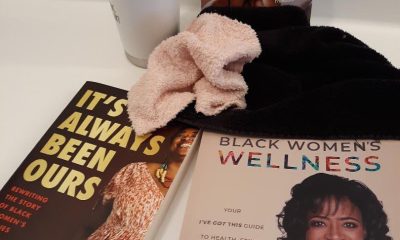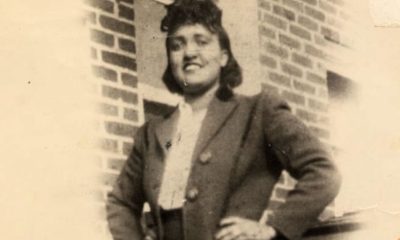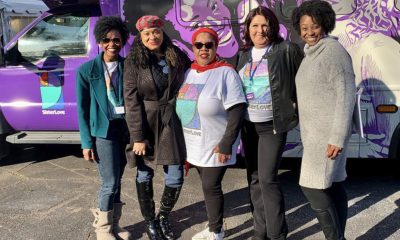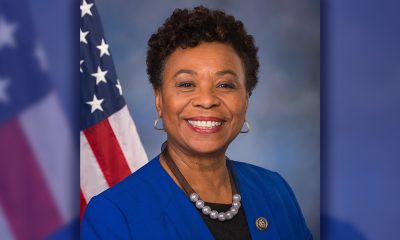Health
Non-Medical HIV Worker Flunk Test on Knowledge of Virus
By Freddie Allen
NNPA Senior Washington Correspondent
WASHINGTON (NNPA) – Most non-medical HIV health care workers earned a “D” when surveyed on the science and treatment of the virus, according to a new report released this week by the Black AIDS Institute.
While 70 percent of the HIV workers scored below 70 percent or the equivalent of an academic “D” grade, just 4 percent earned an “A,” the report said that “The average score on treatment-related questions was 56%, or an ‘F.’”
The Black AIDS Institute (BAI), a national HIV/AIDS think tank focused solely on Black people, surveyed more than 3,600 non-medical health care workers from AIDS service organizations, community-based groups and state and local health departments, “making it the largest ever knowledge assessment of the HIV/AIDS workforce and the first time that anyone looked at the level of science and treatment knowledge in the workforce,” said Phill Wilson, the president and CEO of the Institute.
More than 70 percent of the workers polled said that their organization offered prevention services, 62 percent provided treatment and prevention education, while nearly 50 percent offered treatment and care.
“Black-serving organizations represented the majority (56%) of organizations represented in the survey, with nearly one in three organizations serving people living with HIV (35%) and men who have sex with men (32%),” stated the report. “Seventy-five percent of participants were employees, 12% were consultants, and 13% were volunteers.”
Respondents from Ohio, Pennsylvania and Missouri recorded the highest average scores and North Carolina, Georgia and Florida recorded the lowest scores.
“HIV has evolved over time and today some of the main tools that we use to fight HIV are biomedical tools,” said Wilson. “In order to use those tools you have to have a competency in science and treatment.”
Although better tools exist today, health care professionals who work in the HIV/AIDS field worry that they may not have the labor force skilled enough to properly use those tools.
With a new infection rate that is eight times the new infection rate for Whites, Blacks account for 44 percent of all new infections in adolescents and adults, according to the Centers for Disease Control and Prevention (CDC). Hispanics account for 21 percent of new infections.
Despite increased exposure to the effects of the AIDS epidemic, Black and Hispanic HIV health care workers tested lower than their White peers on the survey.
“This is true even after controlling for education, region of residence, time working in the AIDS field, or any other variable taken into account in the survey,” stated the report.
Wilson said that despite the disproportionate rate of HIV infections among Blacks and Latinos, HIV/AIDS awareness has historically been lower and the stigma associated with the disease has been higher in both communities.
“African Americans and Hispanic respondents may be entering the HIV field with a lower knowledge base concerning HIV/AIDS which increases the need for having training when bringing new staff on board,” said Wilson.
Wilson continued: “We do know that there are elevated levels of stigma in the Black and Latino communities around HIV. People who are entering the field who are Black and Latino are coming into the field with some of that baggage and that may influence their knowledge.”
The stigma is connected to knowledge, Wilson added, and when you increase knowledge you can reduce the stigma.
“If the non-medical healthcare providers and the outreach workers don’t have a high enough level of literacy, they are not equipped to fight the conspiracy theories that are pervasive in our community,” said Wilson. “The more knowledge they have the better equipped they are to address those issues that are in our community.”
Wilson said as more and more people get treatment and have a positive response to the treatment, the stigma will go down.
“This is not the AIDS epidemic of 1986, or 1996 or even 2000,” said Wilson. “Too many people, particularly in our community, still have memories of the old ways that you got tested where there was blood drawn and you had to wait a week or 10 days. Today, you can get an HIV test for free, there’s not necessarily any blood, it can be an oral swab or a finger prick, you can get the results back in a minute; you can even get the results in the comfort of your own home.”
The use of biomedical prevention tools has also emerged.
“In 2011, the HIV prevention enterprise dramatically changed with the release of results from the HPTN 052 trial, which found that antiretroviral therapy reduced the risk of sexual HIV transmission by 96 percent,” the report explained. “The implications of this landmark study were immediately apparent. The very drugs that have transformed HIV infection from an automatic death sentence to one that is often chronic and manageable also have the potential to stop the epidemic in its tracks.”
Wilson said that the most exciting recent developments in the field are the new scientific biomedical prevention tools.
“We now have the ability to potentially reduce HIV transmission by 96 percent,” said Wilson. “What that requires is for us to help people living with HIV to get linked, to care to stay in care and to reach viral suppression.”
Wilson noted that the survey is not an overall evaluation of the knowledge of the workforce, just an analysis of the science and treatment knowledge of the workforce.
“Treatment as prevention is new,” said Wilson. “[Pre-exposure prophalaxis] is new. A lot of these biomedical interventions have only come onboard over the last few years.We’re not saying that [HIV health care workers] have low knowledge about everything, they just have a low knowledge in this particular area.”
Wilson said that it’s important that non-medical health care workers receive training on the current HIV science and treatment tools, because Black people are disproportionately impacted by HIV and that Blacks are also the ones who are going to be disproportionately getting their HIV health care from clinicians who are not HIV specialists.
As more people gain access to health care under the Affordable Care Act, including people who are infected with HIV and those suffering from AIDS-related diseases, health care professionals have to evolve to meet the growing needs of the new consumers.
“We are calling for a national push for increased science and treatment knowledge in the HIV workforce,” said Wilson. “Because that is what it’s going to take to end the AIDS epidemic.”
###
Community
For Cervical Cancer Month, Medical Community Focused on Education
January was Cervical Cancer Awareness Month. Physicians, advocates and others in the medical community commemorated the month by raising awareness about a form of cancer they say is highly preventable and treatable. Cervical cancer is caused by a virus called the human papillomavirus (HPV) and it develops slowly over time but can be prevented with proper care in girls as young as 13 years old.

By Magaly Muñoz
January was Cervical Cancer Awareness Month.
Physicians, advocates and others in the medical community commemorated the month by raising awareness about a form of cancer they say is highly preventable and treatable.
Cervical cancer is caused by a virus called the human papillomavirus (HPV) and it develops slowly over time but can be prevented with proper care in girls as young as 13 years old.
Sonia Ordonez, an OBGYN and gynecology surgeon at Kaiser Permanente, stated that as soon as people with cervixes reach the maturity reproductive age, they should start taking preventative measures like getting the HPV vaccine. The vaccine involves a series of two-doses for people aged 9 through 14 or three-doses for people 15 through 45 years old.
“I see a lot of young women who can’t remember or may not have gotten [the vaccine] when they were younger, or maybe got one, but we can give them the series of vaccines and restart at any point in time,” Ordonez said.
She said that cervical cancer is not the only cancer caused by HPV. Strains of the virus can also lead to throat, anal and penile cancers.
Screening is also an effective way to check for cervical cancer and should be done every three years after someone turns 21, doctors recommend. It is best to start as early as possible to catch occurrences early.
Ordonez said that this cancer is also more likely found in people of color and has led to more deaths overall.
A Mayo Clinic article published last month stated that Black women are more likely to be diagnosed and die of cervical cancer, compared to White women in the U.S.
2,000 Black women are diagnosed every year with cervical cancer and 40% die as a result.
“This disparity is not due to genetic differences among White, Black or Hispanic women, but rather related to systemic racism, access to healthcare and socioeconomic factors,” Dr. Olivia Cardenas-Trowers, a Mayo Clinic urogynecologist, said in the article.
Ordonez stated that immigrant women are also highly susceptible to the cancer, as many Latin American countries may not have accessibility to screenings or lack of insurance makes it harder for them to get tested.
Hispanic women are 40% more likely to be diagnosed with cervical cancer, and 30% more likely to die from it, as compared to non-Hispanic White women, according to the Office of Minority Health.
Family medicine physician, Joy Anyanwu, stated that the pandemic contributed to hesitancy about getting cervical cancer screenings among some women. Other factors are people’s aversion to vaccines, parents not wanting to believe that their children are or will become sexually active, and doubt about the overall effectiveness of the vaccine.
“The vaccine is very safe — over 97% effective in preventing cervical cancer,” Anyanwu said. “Even if you aren’t having sex, the earlier you start would actually help.”
Anyanwu said she understands that parents might not want to ask questions about their children’s reproductive health, but it’s a mindset that can be a barrier to having important conversation about prevention or care.
To keep families their families and communties healthy, the doctor emphasized that people should prioritize keeping up with their vaccine series and going to screenings every year.
Antonio Ray Harvey
Sacramento Lawmakers Step Up Push for “Smart Solutions” on Crime, Public Safety
Assemblymember Tina McKinnor (D-Inglewood) and Sen. Lola Smallwood-Cuevas (D-Ladera Heights), both members of the California Legislative Black Caucus (CLBC), have joined other lawmakers and criminal justice reform advocates to address public safety in the state. On April 2, CLBC members gathered outside the State Capitol for the unveiling of the #SmartSolutions Public Safety Policy Platform, a package of 30 bills that addresses the top concerns of retailers, retail workers, the fentanyl crisis, and support for victims and survivors of crime.
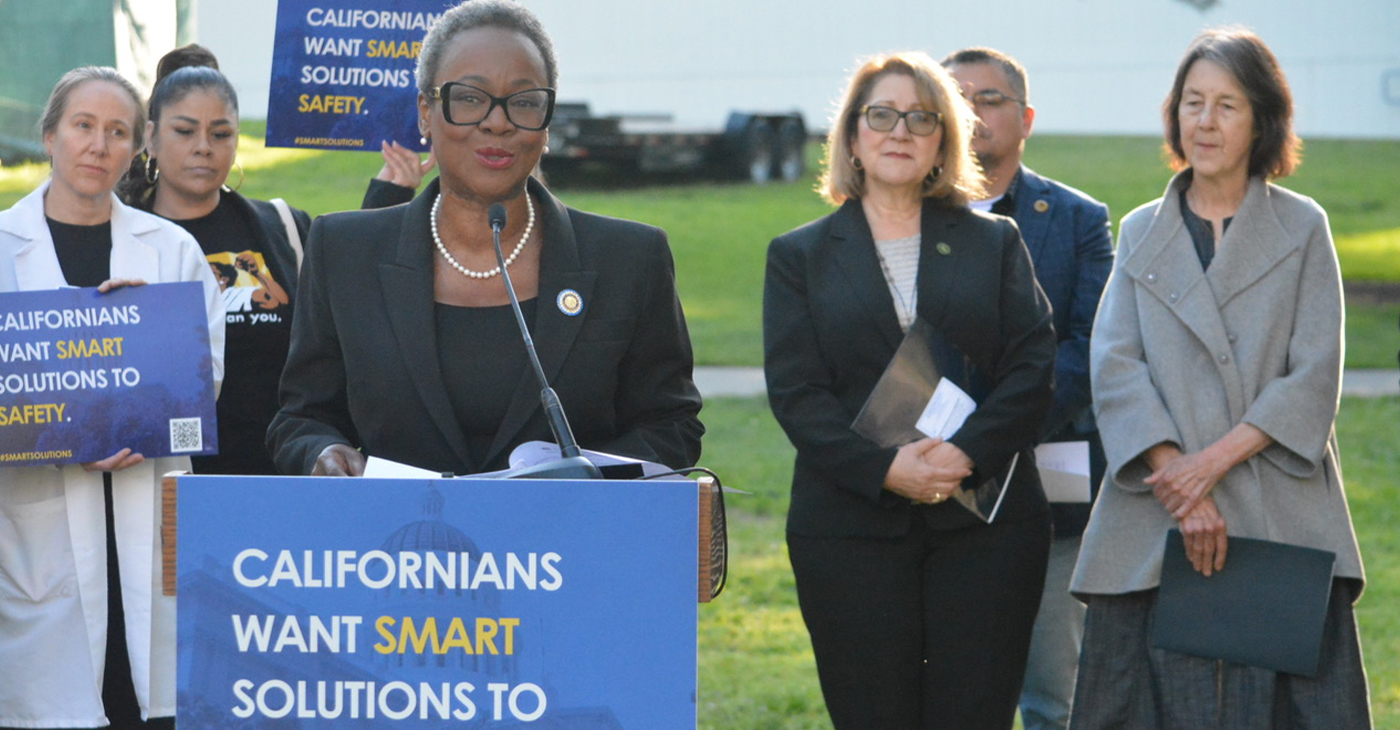
By Antonio Ray Harvey, California Black Media
Assemblymember Tina McKinnor (D-Inglewood) and Sen. Lola Smallwood-Cuevas (D-Ladera Heights), both members of the California Legislative Black Caucus (CLBC), have joined other lawmakers and criminal justice reform advocates to address public safety in the state.
On April 2, CLBC members gathered outside the State Capitol for the unveiling of the #SmartSolutions Public Safety Policy Platform, a package of 30 bills that addresses the top concerns of retailers, retail workers, the fentanyl crisis, and support for victims and survivors of crime.
“Instead of being tough on crime, we need to be smart on crime,” Smallwood said at the press briefing. “I am not saying that we’re not going to be holding folks accountable for the actions that they take. But we will not rely on incarceration as a solution.”
McKinnor, Smallwood-Cuevas, a coalition of advocates, addiction treatment experts, and Yurok Tribal leaders joined Sen. Nancy Skinner (D-Berkeley), and Assemblymember Eloise Gómez Reyes (D-Colton) at the press conference organized to promote legislative solutions that ensure safety and justice.
Organizers say #SmartSolutions is an intersectional campaign that combats criminalization and mass incarceration by pushing for the redirection of state resources to fund housing, health care, schools, services for victims, and programs that reduce recidivism and promote accountability, beyond incarceration.
Opponents of the bills proposed in the #SmartSolutions campaign say their colleagues who support reform-focused strategies are looking the other way on crime and encouraging lawlessness.
For example, Assemblymembers Wendy Carillo (D-Boyle Heights), Carlos Villapudua (D-Stockton) and Mike Gipson (D-Carson) are supporting Assembly Bill (AB) 1990, legislation that would allow a peace officer to arrest shoplifters without a warrant or without witnessing the theft.
Assemblymember James Ramos (D-Highland) authored AB 1772 and introduced it in January. The legislation proposes sterner penalties for retail theft, particularly for repeat offenders.
The #SmartSolutions campaign is co-sponsored by Ella Baker Center for Human Rights, Smart Justice California, American Civil Liberties Union (ACLU) California Action, Californians for Safety and Justice, and Californians United for a Responsible Budget (CURB).
Smallwood recently introduced two bills she hopes will provide solutions to the escalating retail theft problem in the state. Senate Bill (SB) 1446 addresses theft, technology and job security in retail establishments and aims to minimize workplace violence, according to supporters. SB 1282 requires counties to expand the use of a diversion program for theft cases.
“Restorative Justice is the essential pillar of making our criminal justice system more fair, just, and equitable,” McKinnor said. “Restorative justice recognizes the trauma of victims and preparatory of crimes and provides a constructive space for victims to find healing.”
Dr. Amiee Moulin, founder of the California Bridge program and chief of the Division of Addiction Medicine at the University of California (UC) Medical Center, said drug “addiction and overdose” are taking a toll on patients, families and the community.
“I believe that California’s proposed legislation focused on expanding access to treatment is a crucial step towards saving lives,” Moulin said. “By removing barriers to care and embracing evidenced-based strategies we can provide patients the support they need to heal and recover.”
California Black Media
Stakeholders Warn Lawmakers of Expanding Aging Population; Older Black Californians Included
The California Commission on Aging (CCoA) hosted its second annual forum focused on challenges facing Californians over 65 years old. Titled “Aging and Disability Issues: What Legislative Staff Need to Know for 2024,” the virtual event was organized to bring awareness to lawmakers that California’s aging adults are living longer and to emphasize the importance of developing policy to support this growing population, according to organizers.

By Antonio Ray Harvey, California Black Media
The California Commission on Aging (CCoA) hosted its second annual forum focused on challenges facing Californians over 65 years old.
Titled “Aging and Disability Issues: What Legislative Staff Need to Know for 2024,” the virtual event was organized to bring awareness to lawmakers that California’s aging adults are living longer and to emphasize the importance of developing policy to support this growing population, according to organizers.
This year’s meeting included the perspectives of gerontologists and other subject-matter experts who provided data and insights critical to informing policy.
Former Assemblymember Cheryl Brown (D-San Bernardino), who chairs the CCoA’s Executive Committee, began the discussion.
“The landscape of California is changing. Aging is changing and it’s changing California,” Brown said. “Older adults are living longer, and the cohort is becoming more ethnically diverse, underscoring the need to develop culturally, appropriate services.”
The discussion encompassed a range of topics including planning for long-term care, assisted living, enhancing healthcare quality, technology use, services for senior adults with disabilities, state budget considerations, and the best policies and practices to help aging adults stay healthy, active, independent, and confident.
The CCoA acts as the principal advocate for older Californians and as a catalyst for change that supports and celebrates Californians as they advance in age. The CCoA advises the Governor and Legislature, along with state, federal, and local agencies on programs and services that affect senior adults.
Statewide organizations that participated in the event included LeadingAge California, Disability Rights California, California Foundation for Independent Living Centers, and California Collaborative for Long-Term Services and Supports.
In addition, representatives and staff members of Choice In Aging, Age Watch Newsletter, California Elder Justice Coalition, California Association of Area Agencies on Aging, and the California Long-Term Care Ombudsman Association were presenters during the 90-minute discussion.
“In California, we know that older adults are underserved and unserved relative to their needs,” CCoA Executive Director Karol Swartzlander said. “In stark terms, we know that 4% of older adults who need service actually receive services.”
According to the California Department of Aging (CDA), California’s aging population is expected to reach an estimated 4.5 million individuals ages 60 to 69 and 4.2 million senior adults ages 70- to 79 by the year 2040, based on information from CDA’s Master Plan for Aging.
Recognizing that the state’s 65-plus population is projected to grow to 8.6 million by 2030, Gov. Gavin Newsom issued an executive order calling for the development of the MPA.
Debbie Toth, from ChoiceInAging, said the MPA is a model of “how we can do better” to service the needs of older adults. ChoiceInAging, Toth said, “is going to be shopping accessible transportation and rate increases for adult day healthcare.
“But we need to have legislation to do it,” Toth told legislative staff members.
A 2016 California Health Report (CHR) revealed that by 2030, 18% of the state will be 65 or older. Projections in that study also indicated that 52% of these older adults would be from diverse minority groups but “no population is expected to be harder hit than African Americans,” the report stated.
-

 Activism4 weeks ago
Activism4 weeks agoOakland Post: Week of March 20 – 26, 2024
-

 #NNPA BlackPress3 weeks ago
#NNPA BlackPress3 weeks agoCOMMENTARY: D.C. Crime Bill Fails to Address Root Causes of Violence and Incarceration
-

 #NNPA BlackPress3 weeks ago
#NNPA BlackPress3 weeks agoMayor, City Council President React to May 31 Closing of Birmingham-Southern College
-

 #NNPA BlackPress3 weeks ago
#NNPA BlackPress3 weeks agoCOMMENTARY: Lady Day and The Lights!
-

 #NNPA BlackPress3 weeks ago
#NNPA BlackPress3 weeks agoFrom Raids to Revelations: The Dark Turn in Sean ‘Diddy’ Combs’ Saga
-

 #NNPA BlackPress3 weeks ago
#NNPA BlackPress3 weeks agoBaltimore Key Bridge Catastrophe: A City’s Heartbreak and a Nation’s Alarm
-

 #NNPA BlackPress3 weeks ago
#NNPA BlackPress3 weeks agoBaltimore’s Key Bridge Struck by Ship, Collapses into Water
-

 Activism3 weeks ago
Activism3 weeks agoOakland Post: Week of March 27 – April 2, 2024




